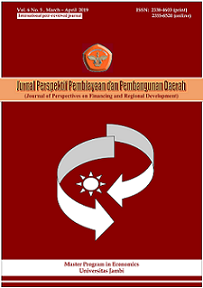Potential analysis of small and medium industries (SMIs) in Lima Puluh Kota Regency, West Sumatra
DOI:
https://doi.org/10.22437/ppd.v6i5.6342Abstract
Small and Medium Industries (SMIs) play an important role in the industrial sector of the Lima Puluh Kota Regency, even though the growth rate has fluctuated in the last six years. The purpose of this study is to identify the potential of Small and Medium Industries (SMIs) Lima Puluh Kota Regency that have comparative and competitive advantages. The analytical methods are location quotient (LQ) and shift-share analysis. Using a variable value of industrial production based on Indonesian Standard Business Classification in five digits of industrial commodity was found, the basic organic chemical industry for raw materials for dyes and pigments, embroidery industry, wood container industry, garment industry of leather, industrial stone goods for home use stairs and displays, the gypsum industry, the components and equipment industry of two- and three-wheeled motorcycles, the soft drink industry and the coconut oil industry are industries that have a comparative as well as a competitive advantage. These industries are suggested to be lead industries in the development of Small and Medium Industries (SMIs) in Lima Puluh Kota Regency.
Downloads
References
Adrimas. (2008). Pembangunan Industri di Sumatera Barat: Pertumbuhan, Permasalahan dan Kebijakan. Jurnal Manajemen dan Pembangunan, 7(2), 2374-2385.
Badan Pusat Statistik. (2009). Peraturan Kepala Badan Pusat Statistik Nomor 59 Tahun 2009 Tentang Klasifikasi Baku Lapangan Usaha Indonesia. Jakarta: Badan Pusat Statistik.
Badan Pusat Statistik Kabupaten Lima Puluh Kota. (2016). PDRB Kabupaten Lima Puluh Kota Menurut Lapangan Usaha 2011-2015. Sarilamak: Badan Pusat Statistik (BPS) Kabupaten Lima Puluh Kota.
Badan Pusat Statistik Kabupaten Lima Puluh Kota. (2017). PDRB Kabupaten Lima Puluh Kota Menurut Lapangan Usaha 2012-2016. Sarilamak: Badan Pusat Statistik Kabupaten Lima Puluh Kota.
Bao-jin, X., Xing-peng, C., & Li-na, W. (2010). Industrial Structure Evolution and Economic Growth in Dingxi City based on Shift-share Method and Location Quotient Analysis. Asian Agriculture Research, 2(12), 61-64.
Irmawati, S. (2015). Analisis Industri Unggulan di Provinsi Jawa Tengah. JEJAK Journal of Economics and Policy, 8(2), 224-237.
Kementrian Perindustrian. (2014). Undang-undang Nomor 3 Tahun 2014 tentang Perindustrian. Jakarta: Kementrian Perindustrian.
Permana, A. I., Marimin, & Suprayitno, G. (2015). Model Konseptual Strategi Pengembangan Industri Kecil Menengah Berbasis Sumber Daya (Studi Kasus Pengembangan IKM di Pangalengan). Jurnal Teknologi Industri Pertanian, 25(1), 14-20.
Pinem, D. E. (2016). Menemukan Strategi Pengembangan Kawasan Industri Melalui Analisis Sektor Unggulan Kota Binjai. Jurnal Wilayah dan Lingkungan, 4(1), 45-64.
Pradigda, E. A. (2016). Strategi Perencanaan Pembangunan Industri Berbasis Produk Unggulan Daerh, Studi pada Dinas Perindustrian dan Perdagangan Kabupaten Blitar. Jurnal Paradigma, 5(3), 112-131.
Sjafrizal. (2014). Ekonomi Wilayah dan Perkotaan. Jakarta: Erlangga.
Sjafrizal. (2016). Perencanaan Pembangunan Daerah Dalam Era Otonomi. Jakarta: PT. RajaGrafindo Persada.
Tan, S. (2010). Perencanaan Pembangunan (Teori dan Implementasi pada Pembangunan Daerah) (1st ed.). Jambi: Fakultas Ekonomi Universitas Jambi.
Tarigan, R. (2009). Ekonomi Regional Teori dan Aplikasi (5th ed.). Jakarta: PT. Bumi Aksara.
Downloads
Published
How to Cite
Issue
Section
License
Copyright (c) 2019 Elfi Khairina, Adrimas Adrimas, Sjafrizal Sjafrizal

This work is licensed under a Creative Commons Attribution 4.0 International License.

















